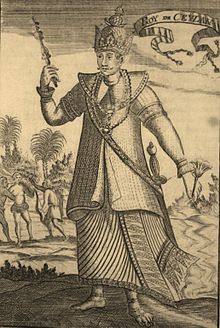Vimaladharmasuriya I.
Vimaladharmasūriya I. ( Sinhala පළමුවන විමලධර්මසූරිය රජ , Tamil முதலாம் விமலதர்மசூரியன் , ruled 1592-1604, died 1604) was King of the Kingdom of Kandy from 1590 to 1604. He earned a reputation as a successful strategist by being successful twice in Portugal Fend off offensives against Kandy: the Campanha do Danture in 1594 and the Battle of Balana in 1602, both times in which the Portuguese were defeated in a humiliating manner .
Surname
Vimaladharmasuriya I. is listed in different sources with four different names. Rajavaliya mentions the name Konappu Bandara, referring to him as the son of a chief of Kandy , Virasundara Mudiyanse of Peradeniya . Reports of the early Dutch visitors Sebald de Veert and Joris van Spilbergen call him Dom João de Áustria . Joao Rebeiro names a Don Juan Appuhamy , a soldier who was sent to conquer the Kingdom of Kandy from Konnapu Bandara . Historians have pointed out that little information about the Kingdom of Kandy is available between 1604 and 1617. Hence, it is quite possible that several people were confused by later historians. According to a document that he gave to the commander of Campanha do Danture, his mother's name was "Kosbokke Gedara Vimalu", after which he got his own name Vimaladharmasuriya.
Life
youth
Vimaladharmasuriya I, probably carried the name "Konappu Banḍāra" before he came to power. He was the son of Galagoda Weerasundara Bandara ( Veerasundara Bandara / Virasundara Mudiyanse ), an aristocrat from Hatara kōrale ("Four Districts", an area that today roughly covers the area Kegalle ). Rajasinghe I. (පළමුවන රාජසිංහ) invaded the Kingdom of Kandy in 1582 with the help of Weerasundara Bandara and overthrew the ruler Karalliyadde Bandara . In the course of the invasion, however, Karaliyadde Bandara managed to flee Kandy with his wife, younger daughter Kusumasana Devi and his nephew Yamasinghe Bandara . The ruler and his wife died on the way, but his nephew and daughter reached the Portuguese fort near Mannar . Rajasinghe I made Weerasundara Bandara regent of Kandy, but soon became suspicious and set a trap for him. Rajasinghe had Weerasundara Bandara come to Seethawaka, where he murdered him. Banḍāra then fled to Colombo ( Portuguese India ). He was sent to Goa by the Portuguese , where he converted to the Catholic faith and performed as Dom João de Áustria . There he got to know the fighting techniques of the Portuguese. Rajasinghe in the meantime appointed Nikapitiye Bandara as regent of Kandy. This was considered a cruel ruler.
Reign

In 1594 Dom João de Áustria married the princess Kusmasana Devi, who, as Doña Catherina , was portrayed as the rightful heir to the throne by the Portuguese, and was proclaimed king. Some time after he took office, the Dutch explorer Joris van Spilbergen offered an alliance to drive the Portuguese out. As a result of the negotiations, Sebald de Weert was officially instructed by Admiral Wybrand van Warwijck to prepare a joint attack against the Portuguese. However, the alliance resulted in disaster as the Dutch started rioting during a feast. According to François Valentijn , De Weert insulted the Queen and De Weert and all 47 companions were subsequently killed. An alliance only became possible again in 1612 when a new envoy, Marcellus de Boschouwer , signed a treaty with the Senarat of Kandy , which ultimately led to the expulsion of the Portuguese from the island and a century of Dutch rule until the British took over the island. Vimaladharmasuriya repudiated Christianity and turned to Buddhism . He then had a two-story shrine built near his palace to create a sanctuary in his capital, Kandy. The tooth relic of the Buddha was brought to the temple ( Sri Dalada Maligawa ) . Vimaladharmasuriya is considered the second founder of the Kingdom of Kandy and his reign led to a renaissance once again.
Buddhism
By the time Vimaladharmasuriya came to power, Buddhism had almost disappeared from the island of Sri Lanka. The king learned that there were no more ordained Buddhist bhikkhus and then sent one of his ministers to Lower Burma (အောက်မြန်မာပြည်) to bring Buddhism back to Kandy. During this time, the Buddha's tooth relic was hidden in the Delgamuwa Raja Maha Vihara (දෙල්ගමුව රජ මහා විහාරය) temple in the Sabaragamuwa district . In addition to the new Temple of the Tooth, the king had numerous other temples built in his domain.
Individual evidence
- ↑ රාජාවලිය - රාජාවලිය iii - Wikibooks . Retrieved May 8, 2017.
- ^ Earliest Dutch Visitors to Ceylon, Nissanka Perera, S. Godage and Brothers, 2008.
- ↑ Kandy Fights the Portuguese, C. Gaston Perera, Vijithayapa Publications, 2007.
- ↑ What happened at Danthure 400 years ago . Retrieved May 8, 2017.
- ↑ Obeyesekere 2017: 161.
- ↑ Ananda Pilimatalavuva: A kingdom is born, a kingdom is lost . March 4, 2007. Retrieved February 8, 2008.
- ↑ Buddhist Monastic Architecture in Sri Lanka: The Woodland Shrines 2008-02-08 Anuradha Seneviratna.
- ↑ Culavamsa
literature
- Gananath Obeyesekere: Between the Portuguese and the Nāyakas: the many faces of the Kandyan Kingdom, 1591– 1765. In: Zoltan Biedermann, Alan Strathern (ed.): Sri Lanka at the crossroads of history. UCL Press, London 2017. ISBN 9781911307846 [1]
Web links
| predecessor | Office | successor |
|---|---|---|
| Rajasingha I. |
King of Kandy 1592–1604 |
Senate |
| personal data | |
|---|---|
| SURNAME | Vimaladharmasuriya I. |
| ALTERNATIVE NAMES | පළමුවන විමලධර්මසූරිය රජ (sinhala), முதலாம் விமலதர்மசூரியன் (tamil) |
| BRIEF DESCRIPTION | King of Kandy |
| DATE OF BIRTH | 16th Century |
| DATE OF DEATH | 1604 |
